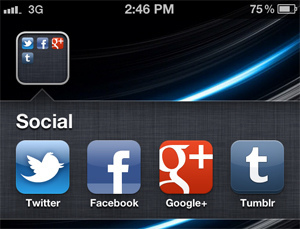By Jessica Wind (The Cascade) – Email
Print Edition: October 24, 2012
There is always that awkward moment when trying to find a way to converse with the non-Facebooker. The truth is, most of us spend more time navigating our various social media sites than actually engaging in human-to-human contact. Real communities—the place where people can come together under common interests or goals—are threatened by the pseudo-substitutions found online.
A considerable amount of fragmentation comes with online communities. My Facebook profile suggests I am incredibly adept at managing a social life, Twitter alludes to my wit and insightfulness, Pinterest makes me look ultra crafty and I am an expert photographer thanks to Instagram. If only all of these were true to the extent that my individual profiles imply. Instead we step into different roles for different sites, easily playing the chameleon for any situation. The result is a confused sense of self and a disjointed sense of belonging. In the human world we take our whole selves, not select pieces, into any community that we choose to belong.
Long before the timeline debacle, Facebook launched what they called community pages, designed to bring people together and a potential response to fragmentation. As stated on their blog in 2010, profiles no longer contained freeform script in the description section; instead, anything a person liked would be linked to a page containing a Wikipedia definition of that thing. For instance, if I felt it was necessary to point out my affection for cash on my profile, it would show up with a clickable image of a wad of cash. Eleven million other people like cash too – who would have thought.
The idea behind the Facebook community pages was to allow users to create a map of all the connections that matter to them, and put them in contact with other users with similar interests. In the real world, this would look like me wearing a sandwich board listing off my interests as I navigated through life. The reality is that I am connected with 11 million strangers instead of being connected to a community business at which I can spend my beloved cash.
Hirschi, a sociological theorist, suggests that attachment and involvement were two of the social bonds necessary to maintain a non-deviant lifestyle. Attachments are relationship based and involvement looks to the time spent within activities that come of these attachments. An online community, while allowing the space to express yourself safely through a computer screen, ignores the human part of this theory.
The use of social media has vastly diminished our sense of what it means to be a part of a community. No longer do we get passionate about issues pertaining to our communities on any level—municipal, regional, provincial, national—or relate in anyway to these places. We do, however, watch the clock during class, waiting for the coveted 10 minute break just so we can check the latest tweets instead of socializing with the living, breathing beings sitting next to us. Instead of operating inside the classroom or even the university community, we tweet and tag and troll among things we are only barely connected to.
Online communities have not replaced real communities and don’t function in the same capacity. Profiles represent a fragmented version of users and force them to broadcast all of themselves at once. Social media has infiltrated our lives and is preventing the human connection that is so necessary for a functional society. That said, I still look at a person like they are speaking some sort of indiscernible language when they tell me that they don’t use Facebook.


